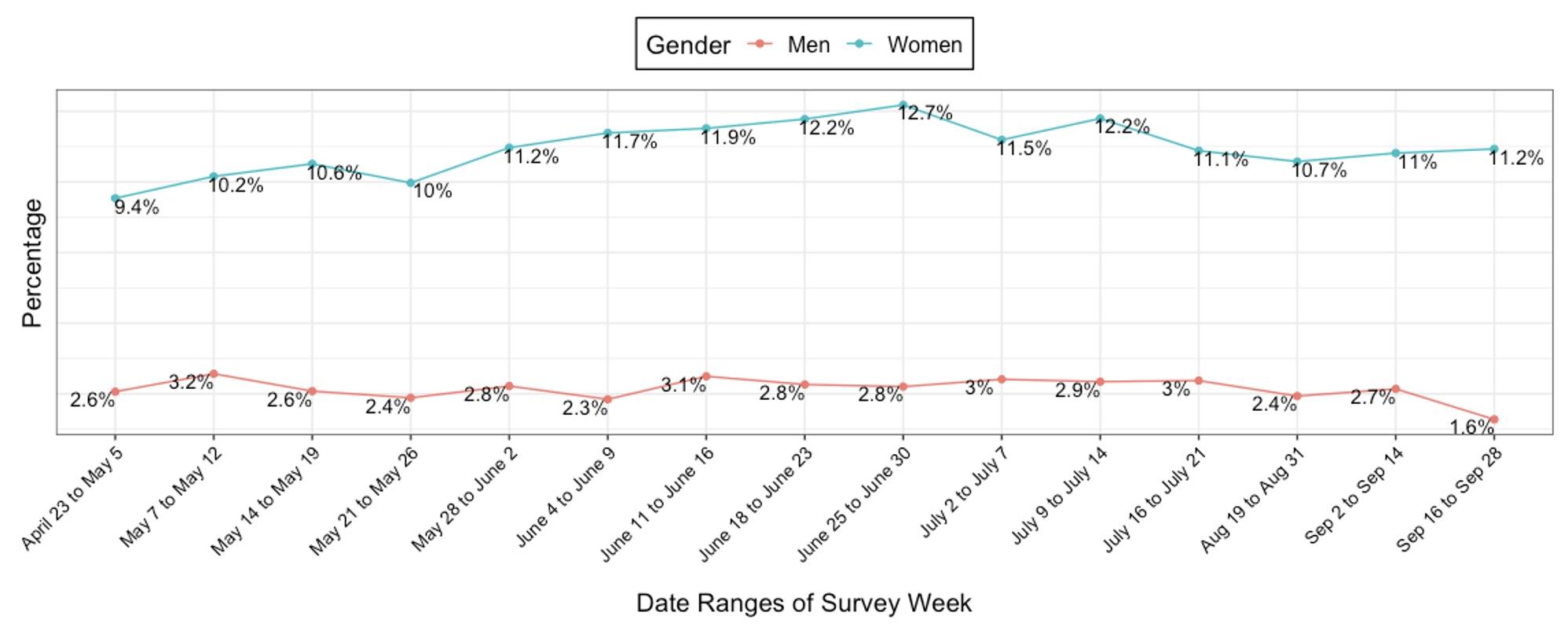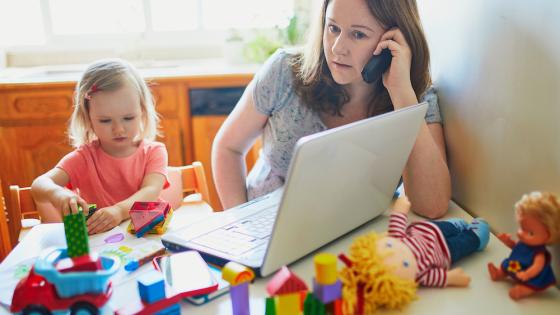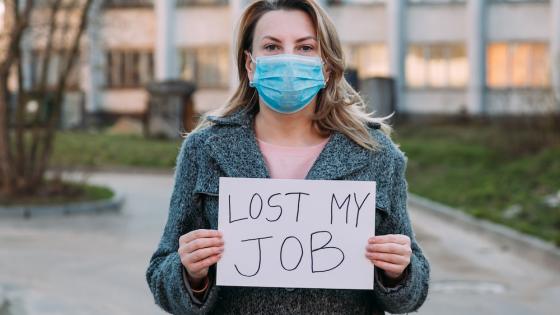The economic recession induced by the COVID-19 pandemic stands in stark contrast to previous recessions in that it has disproportionately impacted women's employment. Alon et al. (2020a) find that prior to 2020, recent recessions have either depressed men's employment more than women’s or had a roughly equal impact. On the contrary, in the 2020 recession, the female unemployment rose by 2.9 percentage points more than the male unemployment rate at its peak (Alon et al., 2020a), and even during the partial recovery period in recent months, the female unemployment rate is still significantly higher than the male unemployment rate.
Many have hypothesised that women’s childcare responsibilities are an important driving factor in differential unemployment effects. With the closure of schools and childcare facilities, parents need to assume additional childcare responsibilities, and this burden has disproportionately fallen on women. Thirty-two percent of the US workforce have a child under age 14, and 9.4% have a child under age 6 (Dingel et al., 2020). Notably, evidence shows that mothers spend more time on childcare than fathers in two-parent households (Alon et al. 2020b). Therefore, there are a priori reasons to believe a decrease in childcare availability will disproportionately affect mothers.
We test this hypothesis rigorously using labour market data from the US. Our study focuses on state-level policies regarding childcare facilities' operation to analyse the effects of loss of childcare on the labour market outcomes of mothers with very young children children (those aged 0 to 5) (Russell and Sun 2020). Since young children require around-the-clock supervision and intensive care from parents, we predict that loss of childcare for very young children may have an even more dramatic effect on mothers' labour supply than public school closures, an issue that has been studied by Heggeness (2020).
Scope of childcare centre closures
To curb the transmission of COVID-19 disease, governments worldwide have introduced a series of stay-at-home orders that have often included the closure of daycare centres. In the UK, childcare providers (schools, colleges, nurseries, and childminders) closed from 20 March to all but the children of essential workers and vulnerable children, requiring millions of children to stay and be looked after at home (Sevilla and Smith, 2020). Japan and Italy also closed daycare centres in late February and early March, respectively, to stem the transmission of diseases among children (Baldwin and Weder di Mauro 2020).
In the US, prior to the pandemic, 24% of children aged 5 and younger received centre-based care from a day care centre, preschool, prekindergarten, or other early childhood programme, and 60% participated at least one weekly in some type of non-parental care arrangement including home-based day cares or care arrangements with a relative (US Department of Education 2016). By mid-March and early April, 16 states had mandated the closure of childcare centres, potentially limiting the ability of parents to access childcare. Another 20 states imposed class size restrictions, typically allowing classes to contain no more than 10 children.
A decrease in the accessibility to childcare facilities lead to an increase in women’s unemployment rate
We focus on the US and investigate the effects of state-mandated childcare centre closures and class size restrictions on women's employment during the pandemic. We use state-level information on childcare centre closure policies to identify states which forced childcare facilities to close or had allowed childcare facilities to remain open subject to class size restrictions. Some states initially closed childcare facilities but then later allowed them to reopen subject to class size restrictions, and we account for this in our analysis.
We use data from the basic monthly files from the Current Population Survey, a monthly survey of about 60,000 households ranging from September 2019 to September 2020, and the Household Pulse Survey, a survey launched in April 2020 specifically to shed light on COVID-19 related issues such as employment status and educational disruptions (US Census Bureau 2020, Centers for Disease Control and Prevention 2020). Figure 1 illustrates that from 23 April to 28 September, the fraction of mothers reporting not working due to COVID-19-related childcare issues are significantly higher than for fathers. For example, from 25 to 30 June, 12.7% of mothers versus only 2.8% of fathers were not working due to COVID-19-related childcare issues.
Figure 1 Percentage of parents aged 18 to 64 by gender and survey week not working due to COVID-19-related childcare issues
Notes: Figure displays the percent of parents aged 18-64 who have at least one child under 18 and report they are not working due to COVID-19 related child care issues among all respondents to the Pulse Survey. Group quarter observations are dropped, and composite weights are used.
Source: Household Pulse Survey Public Use File, United States Census Bureau.
Our regression analysis confirms that a loss of access to childcare discourages women with young children from labour market participation. We use a triple-differences strategy that exploits the variation across states, across time, and across women who did and did not have young children who could have been affected. We find that the closures increased unemployment rates of mothers with young children by 2.7 percentage points in months when a closure was actually in effect. (Note that these were the early months of the pandemic.) In addition, in post-closure months where closures were discontinued but class size restrictions were imposed (later months of the pandemic), unemployment rates were 4.0 percentage points higher than they otherwise would have been. In post-closure months where closures were discontinued and no class size limits were imposed, unemployment rates were 6.6 percentage points higher than they would have otherwise been. The estimates also show a 2 percentage point increase in unemployment rates among mothers with young children in months where class size limits were in effect.
Based on our results, we conclude that the state-level policies that mandated the closure of childcare centres or restricted class sizes did, in fact, increase unemployment rates of mothers of young children in these states. Notably, the negative effects do not disappear once states reopen childcare centres, consistent with previous research suggesting that it takes significant time to reintegrate women in the labour force once out of work (Goldin 2015) or that there is a permanent supply-side impact on childcare availability. For example, it’s possible that financial losses during closure caused centres to permanently shut their doors.
To counter the effects of the COVID-19 recession on working parents, especially on working mothers, many governments have been taking aggressive measures. Australia, for instance, has been providing childcare subsidies to families and financial support to childcare facilities. Djankov et al. (2020) find that this subsidy is one reason female labour force participation has experienced a quick recovery in Australia. Odendahl and Springford (2020) are calling for bold government policies to offset lost wages, such as allowing parents of young kids to take paid sick leave for daycare and school closures and deferring payroll taxes from businesses for three months. These policy advocacies and successful examples of government crisis response measures can serve as a reference for the US in the economic recovery process.
References
Alon, T, M Doepke, J Olmstead-Rumsey and M Tertilt (2020a), “The shecession (she-recession) of 2020: Causes and consequences,” VoxEU.org, 22 September.
Alon, T, M Doepke, J Olmstead-Rumsey and M Tertilt (2020b), “The impact of covid-19 on gender equality”, COVID Economics 4: 62-85.
Baldwin, R and B Weder di Mauro (eds) (2020), “Introduction,” in Economics in the Time of COVID-19, CEPR Press.
Centers for Disease Control and Prevention (2020), “Novel covid-19 survey takes nation's social, mental ‘pulse’”.
Dingel, J, C Patterson and J Vavra (2020), “Childcare obligations will constrain many workers when reopening the us economy”, Becker Friedman Institute Working Paper No. 2020-46.
Djankov, S, T Trumbic and E Zhang (2020), “COVID-19 and the gender gap in advanced economies”, VoxEU.org, 14 December.
Goldin, C (2015), “How to Achieve Gender Equality,” Milken Institute Review Q3: 24-33.
Heggeness, M (2020). “Estimating the Immediate Impact of the COVID-19 Shock on Parental Attachment to the Labor Market and the Double Bind of Mothers”, Review of Economics of the Household 18(4): 1053-1078.
Odendahl, C and J Springford (2020), “Bold policies needed to counter the coronavirus recession”, Centre for European Reform, 12 January.
Russell, L and C Sun (2020), “The Effect of Mandatory Child Care Center Closures on Women’s Labor Market Outcomes During the COVID-19 Pandemic”, COVID Economics 62: 124-154.
Sevilla, A and S Smith (2020), “Baby steps: The gender division of childcare during the COVID-19 pandemic”, IZA Institute of Labor Economics Discussion Paper No. 13302.
U.S. Department of Education, National Center for Education Statistics, (2016), “Early childhood program participation survey of the 2016 national household education surveys program”, (ECPP-NHES:2016).
US Census Bureau (2020), “Measuring household experiences during the coronavirus (covid-19) pandemic”.




